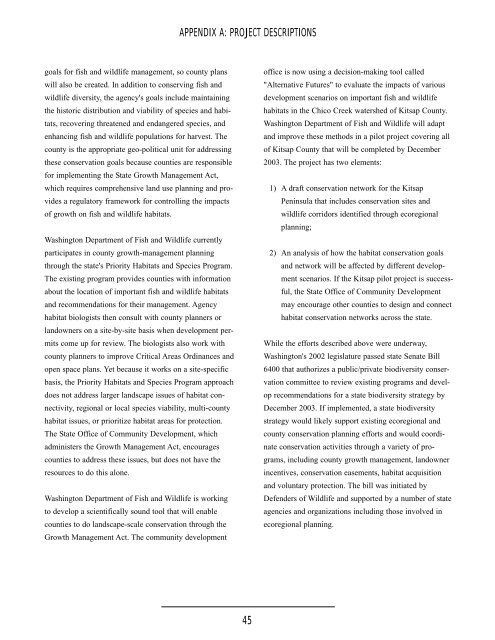Integrating Land Use Planning and Biodiversity - Defenders of Wildlife
Integrating Land Use Planning and Biodiversity - Defenders of Wildlife
Integrating Land Use Planning and Biodiversity - Defenders of Wildlife
You also want an ePaper? Increase the reach of your titles
YUMPU automatically turns print PDFs into web optimized ePapers that Google loves.
APPENDIX A: PROJECT DESCRIPTIONS<br />
goals for fish <strong>and</strong> wildlife management, so county plans<br />
will also be created. In addition to conserving fish <strong>and</strong><br />
wildlife diversity, the agency's goals include maintaining<br />
the historic distribution <strong>and</strong> viability <strong>of</strong> species <strong>and</strong> habitats,<br />
recovering threatened <strong>and</strong> endangered species, <strong>and</strong><br />
enhancing fish <strong>and</strong> wildlife populations for harvest. The<br />
county is the appropriate geo-political unit for addressing<br />
these conservation goals because counties are responsible<br />
for implementing the State Growth Management Act,<br />
which requires comprehensive l<strong>and</strong> use planning <strong>and</strong> provides<br />
a regulatory framework for controlling the impacts<br />
<strong>of</strong> growth on fish <strong>and</strong> wildlife habitats.<br />
Washington Department <strong>of</strong> Fish <strong>and</strong> <strong>Wildlife</strong> currently<br />
participates in county growth-management planning<br />
through the state's Priority Habitats <strong>and</strong> Species Program.<br />
The existing program provides counties with information<br />
about the location <strong>of</strong> important fish <strong>and</strong> wildlife habitats<br />
<strong>and</strong> recommendations for their management. Agency<br />
habitat biologists then consult with county planners or<br />
l<strong>and</strong>owners on a site-by-site basis when development permits<br />
come up for review. The biologists also work with<br />
county planners to improve Critical Areas Ordinances <strong>and</strong><br />
open space plans. Yet because it works on a site-specific<br />
basis, the Priority Habitats <strong>and</strong> Species Program approach<br />
does not address larger l<strong>and</strong>scape issues <strong>of</strong> habitat connectivity,<br />
regional or local species viability, multi-county<br />
habitat issues, or prioritize habitat areas for protection.<br />
The State Office <strong>of</strong> Community Development, which<br />
administers the Growth Management Act, encourages<br />
counties to address these issues, but does not have the<br />
resources to do this alone.<br />
Washington Department <strong>of</strong> Fish <strong>and</strong> <strong>Wildlife</strong> is working<br />
to develop a scientifically sound tool that will enable<br />
counties to do l<strong>and</strong>scape-scale conservation through the<br />
Growth Management Act. The community development<br />
<strong>of</strong>fice is now using a decision-making tool called<br />
"Alternative Futures" to evaluate the impacts <strong>of</strong> various<br />
development scenarios on important fish <strong>and</strong> wildlife<br />
habitats in the Chico Creek watershed <strong>of</strong> Kitsap County.<br />
Washington Department <strong>of</strong> Fish <strong>and</strong> <strong>Wildlife</strong> will adapt<br />
<strong>and</strong> improve these methods in a pilot project covering all<br />
<strong>of</strong> Kitsap County that will be completed by December<br />
2003. The project has two elements:<br />
1) A draft conservation network for the Kitsap<br />
Peninsula that includes conservation sites <strong>and</strong><br />
wildlife corridors identified through ecoregional<br />
planning;<br />
2) An analysis <strong>of</strong> how the habitat conservation goals<br />
<strong>and</strong> network will be affected by different development<br />
scenarios. If the Kitsap pilot project is successful,<br />
the State Office <strong>of</strong> Community Development<br />
may encourage other counties to design <strong>and</strong> connect<br />
habitat conservation networks across the state.<br />
While the efforts described above were underway,<br />
Washington's 2002 legislature passed state Senate Bill<br />
6400 that authorizes a public/private biodiversity conservation<br />
committee to review existing programs <strong>and</strong> develop<br />
recommendations for a state biodiversity strategy by<br />
December 2003. If implemented, a state biodiversity<br />
strategy would likely support existing ecoregional <strong>and</strong><br />
county conservation planning efforts <strong>and</strong> would coordinate<br />
conservation activities through a variety <strong>of</strong> programs,<br />
including county growth management, l<strong>and</strong>owner<br />
incentives, conservation easements, habitat acquisition<br />
<strong>and</strong> voluntary protection. The bill was initiated by<br />
<strong>Defenders</strong> <strong>of</strong> <strong>Wildlife</strong> <strong>and</strong> supported by a number <strong>of</strong> state<br />
agencies <strong>and</strong> organizations including those involved in<br />
ecoregional planning.<br />
45
















![[PDF] Community Development Toolkit - CommDev](https://img.yumpu.com/48616495/1/184x260/pdf-community-development-toolkit-commdev.jpg?quality=85)
